By Frank Iannamico
It took the Auto-Ordnance Corporation nearly twenty years to sell off all of the original 15,000 Thompsons that had been manufactured by Colt. However, in 1939, the German invasion of Poland touched off an unprecedented worldwide demand for weapons, particularly small arms.
In the years following the initial run of the Colt made Thompson, the Auto-Ordnance Corporation, with lagging sales and deeply in debt, fell into the hands of Russell Maguire. In the late 1930’s Maguire had anticipated a major war in Europe, and a demand for weapons. When Maguire obtained the assets of Auto-Ordnance there wasn’t much except for some drawings, prints and a few unsold guns. Maguire at first tried to interest Colt in another production run of the Thompson, but they were already committed to manufacturing other military weapons, and were not interested. Maguire eventually negotiated with the Savage Arms Corporation of Utica, New York to manufacture the Thompson for Auto-Ordnance. In April of 1940, after a twenty-year hiatus, the first Model of 1928 Thompsons were rolling off Savage’s assembly line. The first contract for the new guns was from France, followed by several orders from Great Britain.
These early Savage Thompsons were very much like the Colt 1928 Navy model, featuring a finned barrel fitted with a Cutts compensator, as well as a finely checkered actuator knob, safety and rocker levers. The early Savage guns also featured a vertical foregrip. As per their contracts with A-O, Savage was not permitted to place their name on the Thompsons that they manufactured. The only way to identify a Savage manufactured 1928 or 1928A1 Thompson is by the S prefix on the serial number. All parts manufactured by Savage were also marked with a letter S. Parts manufactured by Savage’s sister plant, J. Stevens, were marked with a block style letter S. Savage and Stevens manufactured virtually every part for the gun except for various screws and springs. All WWII Savage guns were originally assembled at the factory with Savage (S) or Stevens (S) marked parts.
While the Colt Thompsons were blued, the Savage guns were finished by a process called Du-Lite which was a black oxide type III finish. When this finish was applied to a sandblasted surface it had a flat-black appearance. When applied to other surfaces that have not been sandblasted, it had a low luster blue appearance. The outside surfaces of the trigger frames and receivers were sandblasted on Savage Thompsons prior to the Du-Lite finish being applied, resulting in a flat black color. The inside of these components will appear a dull blue color as will the barrel and all other steel parts and components.
The British Contract Savage Model of 1928
The early 1928 Thompson guns manufactured for the British contracts were marked with a very small British inspector’s stamp placed on the receiver and/or the barrel. The guns were purchased directly from the Auto-Ordnance Corporation. The British contract guns were all fitted with the Lyman adjustable rear sight, and a vertical foregrip. The early one-piece flat-machined ejector was fitted to the early guns as well as the early style (2nd design) Cutts compensator. Thompsons fitted with a vertical foregrip came from the factory with only one sling swivel. This swivel was located on the bottom of the buttstock. British armorer’s often relocated the sling swivel to the top of the stock and added a swivel to the side of the foregrip. There were no U.S. or A1 markings on British contract guns. The British purchased 108,000 Thompsons and a large number of spare parts before the enactment of the U.S. Lend-Lease program. In the first contract the British paid $175.00 for each Thompson they purchased, the price was lowered in subsequent contracts. The very early Savage 1928 models shipped to the British had Auto-Ordnance’s New York, NY address roll marked on the left side of the receiver at the rear.

The Savage Commercial Model of 1928
During Savage’s production of the Thompson, the Auto-Ordnance Corporation sold some of the early 1928 model guns to law enforcement agencies. These Thompsons were exactly the same as the British guns described previously, except there were no British (or U.S.) military proofs or markings. It has been a common belief among many collectors, that the Savage “Commercial” guns were equipped with Colt “nickel” internal parts. A close study of these guns reveals that most of them were actually fitted with blued Savage internals. Most of these guns went to police departments where they saw rather limited use. When encountered, the police guns are generally in much better condition than the weapons that saw military service. Most of the “Commercial” model’s receivers were marked with Auto-Ordnance’s New York address. These guns did not have the cross-bolt added to the stock, as that was strictly a military upgrade.
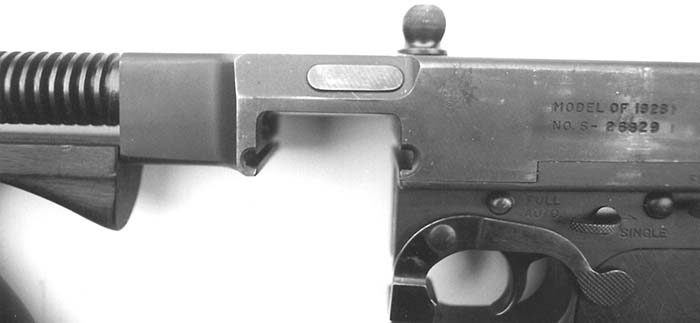
The Savage Model of US 1928A1 (Early Production)
The letter “U.S.” began to appear on the receivers of 1928 model Thompsons after the Lend-Lease Act was passed in 1941. A provision of the act required that all weapons supplied to the allies through the program be U.S. marked. The Thompsons furnished through Lend-Lease were the same as those issued to U.S. forces.
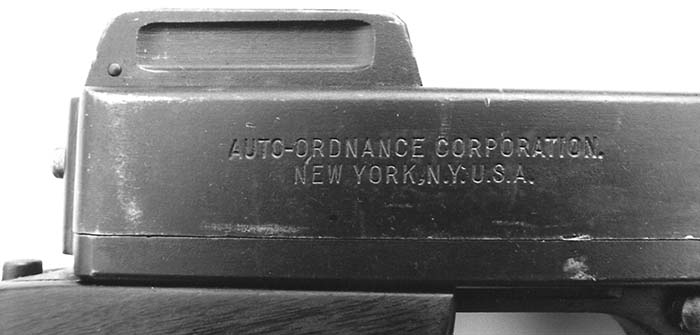
The first U.S. 1928A1 model Thompsons accepted by the United States Ordnance Department were equipped with a Lyman adjustable rear sight and finned barrel. Virtually all military contract Thompsons destined for U.S. service were equipped with horizontal foregrips, although a few of the earlier “Limited Procurement” weapons were equipped with vertical foregrips. All M1928A1 model Thompsons were fitted with the milled front grip mount. Although a few early military Thompsons had the one-piece machined ejectors, most of the U.S. contract guns were equipped with the new three-piece riveted style. The military wood stocks and foregrips on the weapons were of a slightly lesser quality than had been seen on Colt and early Savage “Commercial” guns. Most of the early manufacture U.S. military contract Thompsons had the checkered actuator, safety and rocker levers. Subsequent production saw the elimination of the checkering on the rocker pivot levers, and eventually the safety lever, but the uncheckered actuators did not appear until later in the production run. The milled sling swivels were fitted on these guns.
A few early Savage military contract Thompsons were fitted with the rare 3rd design muzzle compensator that had the Thompson “Bullet” logo stamped on top of the device, and was not marked with the Auto-Ordnance name. Later manufacture Savage M1928A1 Models used the common “military” (4th design) Cutts compensator that featured the “Bullet” logo on the left side and the Auto-Ordnance name roll marked on the top of the unit.
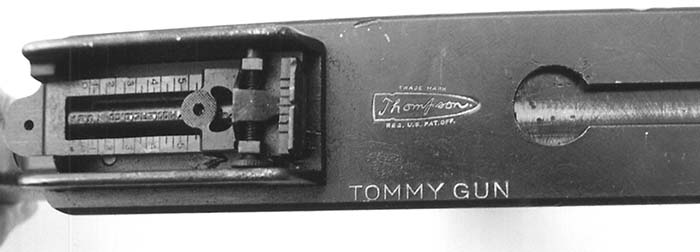
Virtually all U.S. military contract M1928A1 models will have the Auto-Ordnance Bridgeport, Connecticut address roll marked on the right side of the receiver near the center. The patent numbers were marked on the right side at the rear of the receiver. Also stamped on the receivers of Savage Thompsons was the Army Inspector of Ordnance’s initials, as well as the Ordnance Department “flaming bomb” acceptance stamp. Savage guns also were marked with the initials GEG, of George E. Goll, Auto-Ordnance’s chief inspector.
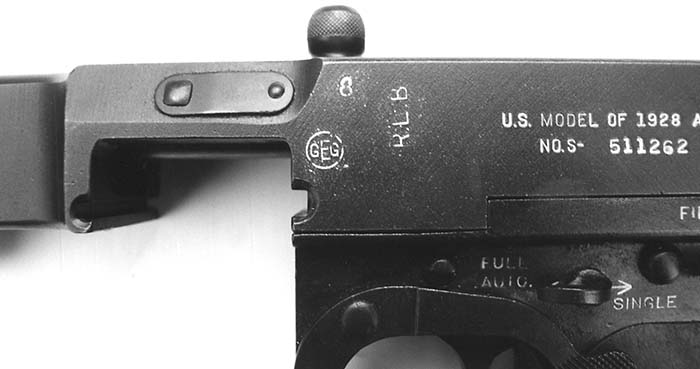
The U.S. 1928A1 (2nd Variation)
The second variation of the M1928A1 Thompsons was fitted with the rudimentary fixed “L” type sight and finned barrel. The fixed “L” aperture style sight was first installed on the M1928A1s manufactured by Savage during contract number G-14 dated 24 February 1942. The contract was for 400,000 weapons. All subsequent M1928A1s were fitted with the “L” sight. The Ordnance Department felt that the M1928A1 Thompson needed a rugged military style sight with a large aperture for rapid target acquisition. Many of the aforementioned guns generally were equipped with the uncheckered safety and rocker levers, but will often have checkered actuators.
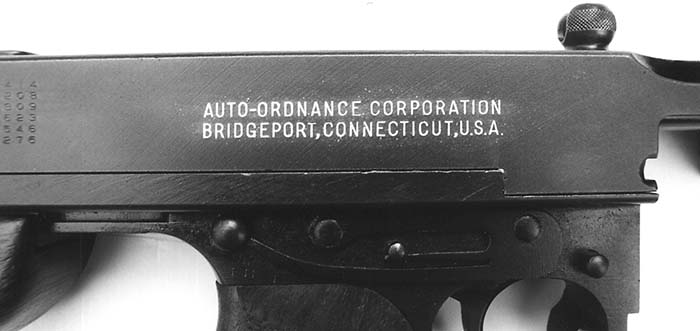
The “L” Sight
At an Ordnance Committee meeting held in December of 1941, it was suggested that a much simpler “L” type of sight replace the complicated Lyman adjustable rear sight on the Thompson. The new sight was better suited for a military application, and would help expedite production of the Thompson. The fixed “L” sight had a .125 inch aperture sighted for a 100-yard range, a second notch was cut into the top of the sight leaf for a 250-yard range. The new “L” aperture style sight was riveted to the receiver in the same manner as the early adjustable model. Lyman also manufactured many of the “L” type sights for Auto-Ordnance and were so marked. The same style of sight was used on early M1 models. The unprotected sight proved to be very easily damaged or bent and would often snag on brush and clothing. A later design provided side ears on the sight for protection of the vertical leaf. The “L” style sight began to appear on the Savage manufactured M1928A1’s at approximately the S-400,000 serial number range.
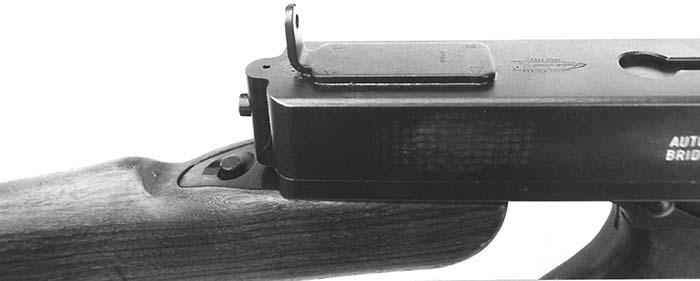
The U.S. 1928 A1 (Late Production)
The Auto-Ordnance Corporation and Savage had a difficult time keeping up with the ever-increasing demand for the Thompson. To increase production they had to either procure more machine tools and increase the work force, or simplify the parts where possible, for easier manufacture.
There were still a few amenities on the 1928 Thompson that could be eliminated in order to expedite the weapon’s production. After the complex Lyman rear sight, the next elaborate feature of the Thompson to be eliminated for the sake of production was the finned barrel. The U.S. Ordnance Department felt that the open bolt feature of the Thompson design provided enough cooling effect to prevent most premature “cook-off” of cartridges, and felt the barrel’s radial cooling fins were not needed. The smooth barrels began to appear on Savage M1928A1’s at approximately serial number S-500,000.
Late manufacture M1928A1 Thompsons were still equipped with the uncheckered, paddle style safety and rocker levers. The checkering feature was eliminated from the actuators on the late M1928A1 models. Many of the late guns were still fitted with milled style sling swivels.
Although most military 1928 Thompsons encountered today will have a reinforcing cross-bolt in the buttstock, the bolt was added after the gun left the factory. The purpose of the cross-bolt upgrade was to prevent the stocks from cracking. The cross-bolt upgrade campaign began after production of the 1928 model had ended.
The first Thompson M1928A1 models were sold to the U.S. government for “$225.00 minus 10%” which calculates to $202.50 per weapon. An additional $2.50 was added for greasing and packing costs. The price paid by the U.S. Government varied from contract to contract but steadily declined from 1941 until the end of production. The price paid by the U.S. Government for a M1928A1 had been reduced to only $70.00 when the new M1 model was introduced in July of 1942. A spare parts kit for the M1928A1 weapon was priced at $15.43.
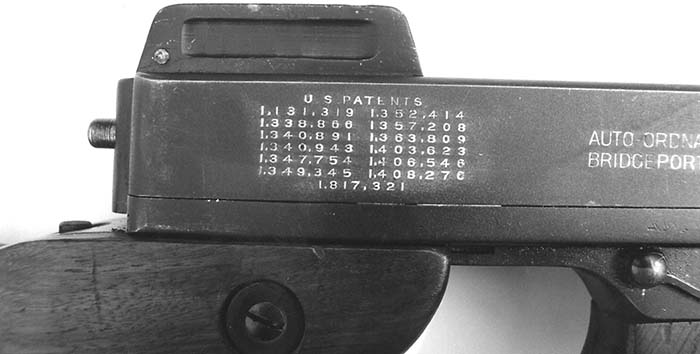
The last 2,000 Savage U.S. M1928A1 Thompsons were manufactured in September of 1942. Thereafter Savage only manufactured the M1 and M1A1 models. Savage manufactured an estimated total of 746,932 model 1928 and M1928A1 Thompsons from April 1940, until October of 1942.
This article is condensed from the book The Military Thompson Submachine Gun, available from Moose Lake Publishing LLC. 207-683-2959 http://www.smallarmsreview.com
| This article first appeared in Small Arms Review V5N5 (February 2002) |











